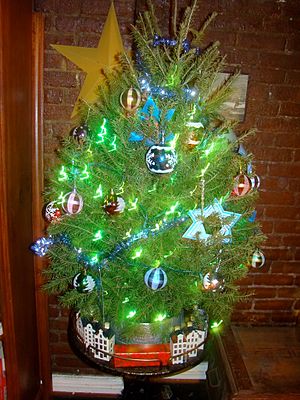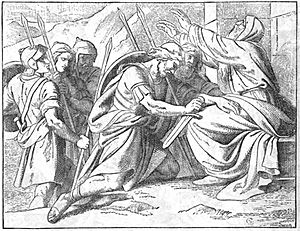Jews and Christmas facts for kids
For a long time, Jewish people have often been a smaller group in countries where most people were Christian. Because of this, a special connection grew between Jewish people and the big Christian holiday of Christmas. This led to unique traditions and even a mix of Hanukkah and Christmas. Some of these practices came from feeling different, while others were just fun things to do when most stores were closed around Christmas.
Contents
How Jewish People and Christmas Connect
A Look Back at History
Judaism and Christianity have always been connected but also very different in their beliefs. In many countries, Jewish people were a minority group and sometimes faced prejudice from Christians. Historically, some Jewish groups created traditions and stories that were different from Christian ones. This was usually done quietly to help keep Jewish culture alive, especially when there was pressure to join the Christian religion.
For example, there's a text called Toledot Yeshu. It was popular among Jewish people long ago and made fun of the Christian stories about Jesus. Even though it wasn't a main Jewish religious text, many Jewish scholars saw it as an important historical record.
According to a scholar named Marc B. Shapiro, the word Christmas doesn't appear in old Jewish religious writings. This is because Jewish law, called Halakha, says not to mention the name of a holiday if it honors a false god. In older Jewish texts, Christmas was called Nittel. This word comes from a Latin term that also gave us the French word for Christmas, Noël.
Jewish Activities on Christmas Day
What is Nittel Nacht?
Nittel Nacht is a name used in old Jewish writings for Christmas Eve. On this night, some Jewish communities, especially Hasidic Jews, traditionally did not study the Torah (their holy book). This practice started a long time ago and included other traditions like eating garlic and having social gatherings. However, not all Jewish groups followed this; some believed Torah study should continue on Christmas Eve.
Chinese Food on Christmas
In the United States, a popular Christmas tradition for many Jewish Americans is eating Chinese food. This started way back in the 1800s. Jewish and Chinese communities lived close to each other in Manhattan's Lower East Side, which helped the tradition begin. The first time Jewish people were recorded eating in Chinese restaurants was in 1899. Back then, a Jewish newspaper even criticized it because it went against some kosher food rules.
Today, this tradition has spread across America. A Chinese restaurant in Chicago once reported that their reservations tripled on Christmas Day, with half of them being Jewish customers. This tradition has also been featured in many funny comedy shows. When Judge Elena Kagan was being considered for the Supreme Court, a senator asked her what she did on Christmas. She famously replied, "You know, like all Jews, I was probably at a Chinese restaurant," which made everyone laugh.
There are many reasons for this tradition. Chinese restaurants are usually open on Christmas Day. Also, Chinese food often doesn't mix meat and dairy, which is a rule in kosher law. More importantly, for many Jewish people, this tradition shows that they are different from those who celebrate Christmas. It unites Jewish and Chinese people in their shared experience of not celebrating the holiday.
Matzo Ball Parties
The Matzo Ball is a big party held every year on Christmas Eve in many major cities in the United States and Canada. It's for Jewish single people in their 20s and 30s. The event was created to give Jewish people something fun to do on a night when they might otherwise feel alone or have nothing planned. People go to dance, meet new friends, or just hang out. There are also other similar parties, like "The Ball."
Jewish People Celebrating Christmas
What is Chrismukkah?

The word Chrismukkah is a mix of Christmas and Hanukkah. It became popular after a TV show called The O.C. used it in 2003 to describe combining the two holidays. A company even started selling related items. However, some religious groups, like the Catholic League and the New York Board of Rabbis, said it was a "multicultural mess" that disrespected both Christians and Jews.
Similar words exist in other languages. In German, it's Weihnukka, and in French, it's Hannoël.
Chrismukkah Traditions
Sometimes, people blend Christmas and Hanukkah traditions. For example, Christmas trees might be decorated with Jewish symbols or Hanukkah decorations. These trees are sometimes called "Chrismukkah trees" or "Hanukkah bushes."
Christmas Songs by Jewish Writers
Many popular Christmas songs, especially in the United States, were written by Jewish composers. These include famous tunes like "White Christmas", "The Christmas Song", "Let It Snow", and "Rudolph the Red-Nosed Reindeer". These songs often focus on the fun, non-religious parts of Christmas, making it feel like an American holiday. One writer even said that almost the "entire sound track" of Christmas was written by Jewish people.
Hanukkah and Christmas: A Special Connection
How Hanukkah's Importance Grew

During the American Civil War, some Jewish leaders saw the Maccabees (the heroes of the Hanukkah story) as a symbol of strength. They wanted to resist Jewish people blending into Christian culture, especially as Christmas became more popular. In the late 1800s and early 1900s, Christmas decorations and gift-giving became very common in the U.S. Many rabbis were worried that American Jews were adopting these practices for their Hanukkah celebrations.
Some German Christmas traditions were even adopted by German Jews in the 1800s. When many of them moved to Cincinnati, Jewish newspapers there worried about this mixing of customs. To help, rabbis like Isaac Mayer Wise and Max Lilienthal created special Hanukkah celebrations for Jewish children, with singing and speeches. Another rabbi, Solomon H. Sonneschein, even suggested moving Hanukkah to December 25 to match Christmas.
The Zionist movement also embraced Hanukkah because it showed Jewish strength and victory. In 1896, a rabbi visited Theodor Herzl, a key Zionist leader, and saw him celebrating Christmas. The rabbi convinced Herzl to take down his Christmas tree and celebrate Hanukkah instead. Herzl later wrote an essay called "The Menorah", arguing that Jewish people rejecting Christmas and celebrating Hanukkah was important for their self-respect.
In the early 1900s, Hanukkah became a way for American Jews, especially women, to feel more connected to their Jewish identity during a time when Christianity was everywhere.
Hanukkah Today
The Jewish holiday of Hanukkah was traditionally a smaller holiday. However, in the modern United States, it's seen as very important because it happens around the Christmas and holiday season. Many American Jews see it as a Jewish version of Christmas. Information suggests that Hanukkah's popularity in the U.S. is due to its closeness to Christmas. American Jews might use Hanukkah to give their children an alternative to Christmas. Some Jewish people and rabbis have worried about this minor holiday becoming too important. For example, in 1990, the Women's League for Conservative Judaism said that "any child who has built a sukkah will not feel deprived of trimming a [Christmas] tree," suggesting that a bigger focus on Hanukkah wasn't really needed.
See also
- Christianity and Judaism
- Christmas and holiday season
- Christmas controversies
- Christmas in Israel
- The Chanukah Song
- The Latke Who Couldn't Stop Screaming: A Christmas Story


